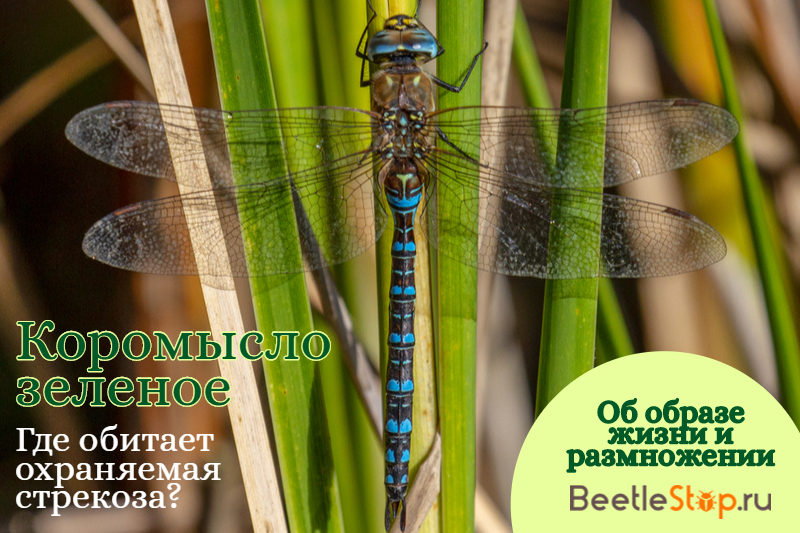Rocker green - lakeside homebody
Representatives of the rocker family (Aeshnidae) are found in the northern part of Eurasia and America. Large dragonflies with different wings are distinguished by a motley coloring of bodies and a characteristic position of the body during rest. When planted on plants, they hold the front of the body vertically, and lower the abdomen down. Rocker green is one of the species that has spread from Europe to Siberia. In some areas, the number of dragonflies has decreased significantly. The species is threatened with extinction due to pollution of water bodies and destruction of vegetation.
Morphological description
Rocker green (Aeshna viridis) is a species from the family and genus Rocker. The body of a dragonfly reaches a length of 65-75 mm. Thin slender abdomen accounts for 48-54 mm. The color is mottled, with a predominance of blue and green. Pre-humeral and lateral parts of the chest with wide green stripes. Blue spots are visible at the base of the wings. The abdomen of the male is covered with a pattern of black and blue spots, the females are painted in a combination of green and brown.

Information. Females are slightly larger than males in body size and wingspan (the rear wing of the male is 38-41 mm, females - 41-45 mm).
The head is large, mobile, if necessary, can be rotated 180 °. Complex facet eyes occupy almost its entire lateral surface. In a small area, they are in contact with each other. Black stripes on the forehead form the letter T. On the crown of the head are three simple eyes. The gnawing mouth apparatus, jagged jaws easily grind small insects. In front of the eyes on the forehead are tiny black antennas.
Wings are transparent, venation is dark, pterostigma is gray, up to 3 mm long. The head and chest of the dragonfly are covered with thin short hairs. The limbs are black, composed of 5 parts. on tibia of forelegs two rows of spines. The female ovipositor is short, has lateral plates and does not reach the end of the abdomen.
Habitat
The Palearctic species spread from Central Europe to Siberia. The green rocker is found in the south of Finland and Sweden, in the Baltic countries, the Netherlands, Poland, and Ukraine. In Russia, lives in European regions, Crimea, southern Siberia. Dragonflies are found in Central Asia. The distribution of the species is local.
Lifestyle & Habitats
Typical habitats of the green rocker are lakes, elders, large ditches and canals, and other artificial reservoirs. The active summer of adults is from June to September (October). Dragonflies are not prone to long-distance flights. They do not move more than 500 m from water bodies selected as a breeding place. Unlike other representatives of the genus, they are active not only during the day, but also in the evening twilight. For males, pronounced territorial behavior is characteristic. They set the boundaries of individual sites and regularly patrol. Dragonflies accidentally flown awaits a battle with a large enemy.
Insects spend night hours in the crowns of nearby trees. Reproduction of the green rocker is associated with a special plant - teloresis. Females lay eggs in his tissue. In the absence of this plant, the masonry is placed in other hydrophytes.During the process, the female gradually descends through the plant, piercing the stem in different places and placing an elongated egg inside. Long incubation takes 9 months. only next year, in spring, small nymphs (larvae) will appear.
Larval development
The offspring of the rocker arm has a sedentary lifestyle. They have an elongated strong body, a large head with faceted eyes. The mask with which the nymphs get food is flat. Larvae do not have external gills, respiratory organs (trachea) are located in the intestinal walls. Predators eat any prey that they can overcome. Together with daphnia, larvae and water donkeys, they eat fish fry. The development of nymphs lasts 1.5-2 years. After more than 5 links, they are selected on the stem of an aquatic plant, where the skin is last dropped. A young winged dragonfly appears.
Species reduction and conservation
Changes in natural habitats affect the abundance of the species. It is steadily declining in Western Europe and some regions of Russia. main limiting factors:
- reduction of open water areas;
- recreational load on coastal areas;
- water pollution;
- deficit of lakes and ponds with thickets of teloresis.
Dragonflies Aeshna viridis are protected in Europe, they are listed in the IUCN Red List, as a threatened species. A catastrophic decline in the population is observed in Belarus and Lithuania, in these countries the insect also fell into the Red Book. In Russia, dragonflies were taken under protection in many areas: Leningrad, Moscow, Penza, Lipetsk, Novgorod.

